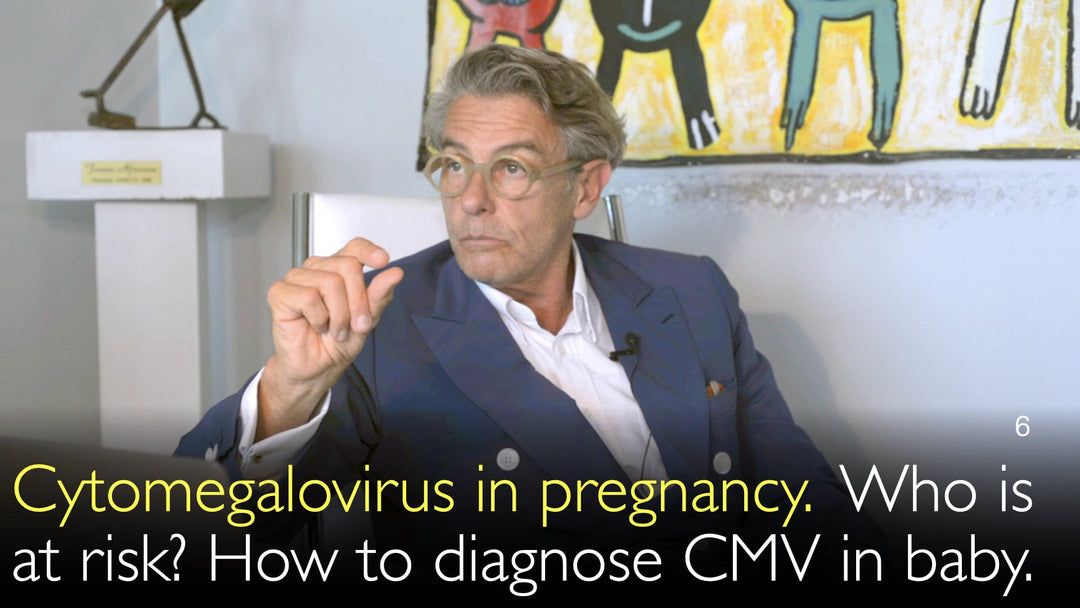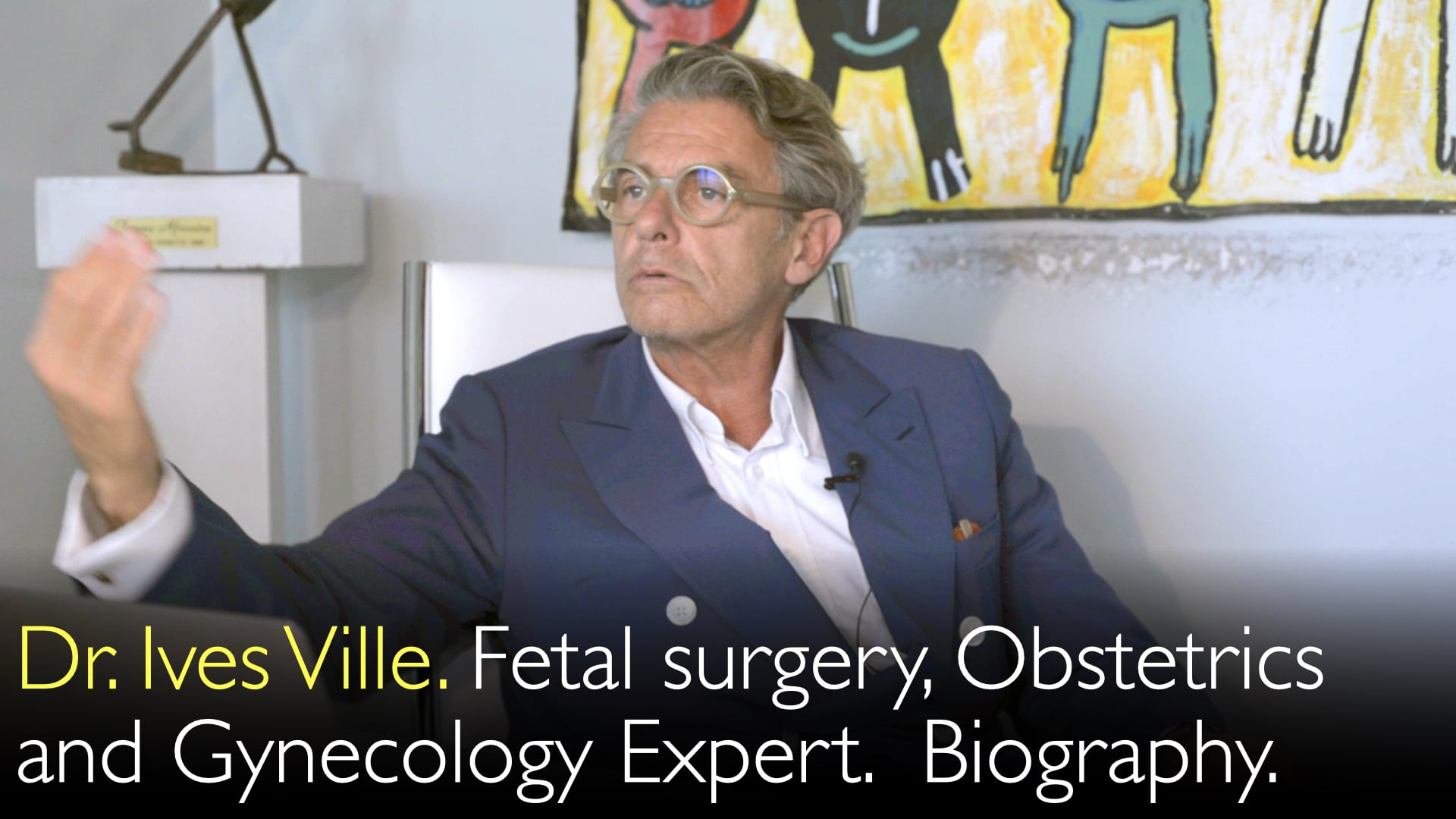מומחה מוביל ברפואת אם ועובר, ד"ר איב ויל, MD, מסביר את הסיכונים של ציטומגלווירוס בהריון. הוא מפרט כיצד מתרחשת העברת CMV ומתאר אסטרטגיית סקר ברורה. ד"ר איב ויל, MD, דן בסיכון ההדבקה הגבוה של 10% בקרב נשים הרות מסוימות. הוא תומך בביצוע בדיקות סרולוגיות בטרימסטר הראשון לזיהוי הדבקות ראשוניות אחרונות. טיפול אנטי-ויראלי עם ולציקלוביר יכול להפחית את סיכון ההעברה לעובר מ-30% ל-10%. ד"ר ויל גם מכסה הליכים אבחוניים כמו דגימת סיסי שלייה ומי שפיר לאישור הדבקה עוברית.
ציטומגלווירוס בהריון: גורמי סיכון, סקירה ומניעה
קפיצה לפרק
- פרופיל מטופלות בסיכון גבוה לציטומגלווירוס
- העברת CMV ומניעה ראשונית חסרת תקווה
- מניעה משנית של CMV באמצעות טיפול אנטי-ויראלי
- המחלוקת סביב סקירת CMV והנחיות
- הבדלים בין הדבקה ראשונית ולא-ראשונית ב-CMV
- גישה מעשית לסקירה ואבחון CMV
- תמלול מלא
פרופיל מטופלות בסיכון גבוה לציטומגלווירוס
ד"ר איב ויל, MD, מזהה אוכלוסייה ספציפית בסיכון גבוה להדבקה ראשונית בציטומגלווירוס. המטופלת האופיינית היא אישה צעירה מרמה סוציו-אקונומית גבוהה. לרוב יש לה ילד ראשון בן שנתיים או שלוש. ילד זה בדרך כלל נמצא במעון יום בזמן האם עובדת.
ד"ר איב ויל, MD, מציין שפרופיל זה נושא סיכון פרוספקטיבי של 10% להידבקות ב-CMV במהלך הריון שני. זה מייצג סיכון גבוה מאוד ברפואה perinatal. למרות סיכון ידוע זה, אף מדינה לא תומכת כיום בסקירה אוניברסלית ל-CMV בהריון.
העברת CMV ומניעה ראשונית חסרת תקווה
העברת ציטומגלווירוס מתרחשת דרך נוזלי גוף מרובים מילדים נגועים. ד"ר איב ויל, MD, מסביר שהווירוס נמצא בדמעות, רוק, שתן וצואה. כ-80% מהילדים במעונות יום מפרישים CMV בשתנם.
ילדים אלה יכולים להפריש את הווירוס למשך שנתיים עד ארבע שנים. זה הופך הימנעות לכמעט בלתי אפשרית. אפילו נוהלי היגיינה זהירים לרוב אינם מספיקים. ד"ר ויל מתאר מניעה ראשונית כ"חסרת תקווה" מכיוון שבני זוג יכולים גם להידבק ולהעביר את הווירוס לאישה ההרה.
מניעה משנית של CMV באמצעות טיפול אנטי-ויראלי
מניעה משנית מציעה יתרונות משמעותיים להדבקה בציטומגלווירוס. ד"ר איב ויל, MD, מדגיש שסקירה מוקדמת יכולה לזהות הדבקות ראשונית recent. טיפול ב-valacyclovir יכול אז להפחית דרמטית את סיכון ההעברה.
ללא התערבות, שיעור ההעברה העוברית להדבקה ראשונית ב-CMV הוא כ-30%. טיפול ב-valacyclovir מפחית סיכון זה פי שלוש, מוריד אותו לכ-10%. הפחתת סיכון משמעותית זו מספקת טעון חזק ליישום תוכניות סקירת CMV בתחילת ההריון.
המחלוקת סביב סקירת CMV והנחיות
ד"ר איב ויל, MD, מתייחס למחלוקת המתמשכת סביב סקירת ציטומגלווירוס. רשויות בריאות לרוב מביעות דאגה לגבי דאגת נשים הרות ללא צורך. עם זאת, ד"ר ויל טוען שנשים משכילות בקטגוריות סיכון גבוה רוצות מידע זה.
האתגר טמון במחקר מיושן המזהם את הספרות הנוכחית. ד"ר איב ויל, MD, קובע שיש להתעלם ממחקרים בני יותר מארבע שנים עקב מתודולוגיות לא מדויקות. ועדות בריאות לרוב מסתמכות על נתונים ישנים אלה, יוצרות מכשולים ליישום הנחיות סקירה מודרניות למרות התקדמויות recent בהבנה.
הבדלים בין הדבקה ראשונית ולא-ראשונית ב-CMV
הדבקה בציטומגלווירוס מתנהגת שונה מהדבקות perinatal אחרות כמו טוקסופלזמוזיס. ד"ר איב ויל, MD, מסביר שנשים יכולות לחוות הדבקות CMV לא-ראשונית even עם immunity קודמת. גורמי הסיכון להדבקות לא-ראשונית שונים significantly מהדבקות ראשונית.
CMV ראשונית מתואמת strongly עם ילד במעון יום. הדבקה לא-ראשונית נראית associated עם צפיפות ומגע קרוב עם מספר ילדים. Epidemiology משתנה לפי מדינה—בחלק מהאומות כמו סין ווייטנאם, כמעט 100% מהאוכלוסייה immune, yet יש להם still 1-4.3% תינוקות הנולדים עם הדבקת CMV מהדבקות אימהית לא-ראשונית.
גישה מעשית לסקירה ואבחון CMV
ד"ר איב ויל, MD, מספק גישה מעשית clear לסקירת ציטומגלווירוס. נשים המתכננות הריון או already הרות עם ילד נוסף צריכות לבקש סרולוגיה ל-CMV (בדיקת IgG/IgM). תוצאה שלילית means אין הדבקה קודמת, דורשת היגיינה זהירה during הטרימסטר הראשון עם בדיקה חוזרת בשבוע 15.
אם both IgG ו-IgM חיוביים, בדיקה נוספת עם IgG avidity יכולה לקבוע תזמון הדבקה. הדבקות occurring within שלושה חודשים דורשות consideration כסיכון גבוה. ד"ר ויל ממליץ על טיפול ב-valacyclovir ו-either CVS בשבוע 13-14 או דיקור מי שפיר בשבוע 16-17 לאבחון definitive. הוא מעדיף CVS מכיוון שהוא מספק certainty לגבי status הדבקה בטרימסטר הראשון.
תמלול מלא
ד"ר אנטון טיטוב, MD: איך usually נשים הרות נדבקות בציטומגלווירוס? איך הצעד הראשון בחשד להדבקת ציטומגלווירוס usually עולה?
ד"ר איב ויל, MD: נכון. אז כפי שציינתי, יש שני סוגים של הדבקת ציטומגלווירוס: לא-ראשונית וראשונית. מה שאנחנו יודעים everything עליו הוא הדבקה ראשונית בציטומגלווירוס. זהו sketch אופייני של ה-target לווירוס: אישה צעירה עם רמה socio-economical גבוהה, whose התינוק הראשון already בן שנתיים או שלוש. usually, תינוק זה first left במעון יום because האם works during היום.
זהו sketch אופייני; 99% ממקרי הציטומגלווירוס הם כך. זוהי אוכלוסייה בסיכון גבוה very because נשים עם profile זה, prospectively, when הן enter להריון second, יש להן סיכון 10% להידבק בציטומגלווירוס. אין סיכון גבוה כזה anywhere else ברפואה perinatal. And yet, אף מדינה בעולם advocate לסקירה לציטומגלווירוס.
Even though profile זה של נשים known, and הציטומגלווירוס circulates במעון. הן נדבקות מילדיהן. הווירוס everywhere בתינוק: בדמעות, ברוק, שתן, וצואה. So it's very difficult להימנע ממגע, even if הן careful.
Also sometimes, which is a shame, הן do know; הן very careful themselves, and הן ask הבעל to do the job. And then הבעל is not immune, gets ציטומגלווירוס, and then contaminates האם. So it's hopeless מניעה ראשונית.
What has been shown recently is that מניעה משנית של ציטומגלווירוס is also efficient. So if you screen early, and you get aware of a recent primary infection, valacyclovir—that I mentioned treating infected fetuses—you give to the mother, and you decrease the risk of transmission threefold. Instead of 30%, you go down to 10%. So it's another argument in the recent months or years to advocate for cytomegalovirus screening.
But when you advocate for screening in pregnancy, especially recently, there is a lot of controversy. "You're going to worry women for nothing." If I'm 35 years old, I'm well educated and well off. I've got my first baby in a daycare center. I want to know if I have a 10% risk of getting this nasty infection, I think.
ד"ר אנטון טיטוב, MD: What is the right way to go about cytomegalovirus? Should the kids, the first child, be screened regularly or the husband or only the pregnant woman?
ד"ר איב ויל, MD: Only the pregnant woman needs cytomegalovirus screening. The child will have this cytomegalovirus virus. 80% of children in a daycare center pass CMV in their urine. 80%. And when they do pass the CMV in their urine, they do it for 2, 3, 4 years. There's no point in screening children for cytomegalovirus. Only the pregnant woman needs cytomegalovirus screening.
The effort is the first trimester. Again, the big step forward is that we've shown that after the first trimester, cytomegalovirus doesn't matter. Screening for cytomegalovirus by the serology? Our research program focuses now on non-primary cytomegalovirus infection because there is no marker currently of non-primary cytomegalovirus infection. And it's hard for pregnant women. So that's important.
ד"ר אנטון טיטוב, MD: Is there any new possibility that it will be included in any screening guidelines, or there isn't?
ד"ר איב ויל, MD: We've been pushing for this for years. The latest cytomegalovirus screening offer was two years ago, and it was not accepted by the health authorities. I think it's a big mistake now. But things are moving so fast.
When you question health authorities, they convene independent committees to look at the problem. Then they look at the literature. And the literature on CMV—you can put in the trash bin everything that is older than four years. Because everything older than that will be a fable of things that are not accurate, that are mixing up different things.
So the literature is polluted by the old studies. And still, those committees do not want to look only at recent research series because they need to have a deeper view. After all, they don't know anything about the cytomegalovirus problem. So it's hopeless.
ד"ר אנטון טיטוב, MD: So cytomegalovirus can happen again, which could be a secondary infection. It is different from toxoplasmosis, which, if somebody had it before, they wouldn't have it again.
ד"ר איב ויל, MD: Exactly. You can get a non-primary cytomegalovirus infection. The risk factors for cytomegalovirus are not the same. They probably need to be sorted country by country.
For example, in China, in Vietnam, in India, the number of babies—proportion of babies born infected with cytomegalovirus—it's about 4.3% and 1%. The same thing in France here, for example. But all of them are nearly born from non-primary cytomegalovirus infections in the mother because this population is immune, nearly 100% of the population nearly. But still, they do have the same rate of infection at birth.
Whereas France, Holland, Great Britain, it's about 50/50. So, for these countries, it's different. We run a cytomegalovirus program at the moment with Vietnam. We need to find cytomegalovirus markers that can identify non-primary cytomegalovirus infection also early in pregnancy.
Whether this is a primary or non-primary cytomegalovirus infection, the clinical problem is early in pregnancy, not afterward. So we're making progress. All these recent advances have occurred within three, four years.
ד"ר אנטון טיטוב, MD: So if a pregnant woman or a woman who is planning pregnancy and already has a child is seeing this conversation, what should she do?
ד"ר איב ויל, MD: She should ask for cytomegalovirus serology (IgG/IgM testing). If she's got a negative serology, no IgM, no IgG, she should be careful for the first three months. Then she should check once more at about 15 weeks. If she's still negative for cytomegalovirus, she doesn't need to worry about it. Cytomegalovirus can happen and it's no problem.
In the first trimester, when she checks, we find IgM and IgG—not IgM alone, IgM alone is nothing—IgG and IgM. That means she had a recent infection. You can be a bit more precise by asking for IgG avidity, which is a characteristic of the IgG. You sort the old antibodies from young antibodies, so to speak.
And the IgG avidity will tell you if cytomegalovirus infection happened more than three months ago or less than three months ago. If it was less than three months ago, then she has to be considered as a high risk. She has to be put on valacyclovir.
ואז היא יכולה לעבור או דגימת סיסי שליה (CVS) בשבוע 13, ממש בסוף הטרימסטר הראשון, או דיקור מי שפיר בשבוע 16 או 17. אני בהחלט מעודד אנשים לעשות זאת מוקדם יותר, כלומר בשבוע 13-14 להריון, כי אם דגימת הסיסים שלילית בשבוע 13-14, אתה בטוח שאין סיכון לעובר.
אם מבצעים דיקור מי שפיר בשבוע 17, והתוצאה חיובית, אתה לא יודע אם הזיהום בציטומגלווירוס קרה ממש עכשיו או אם קרה לפני שבוע 14. כך שעדיין יש אי-ודאות של חודש. אז אני מעדיף להיות בטוח בטרימסטר הראשון, ממש בסופו. ואם דגימת הסיסים חיובית, אז שוב מדובר בטיפול אנטי-נגיפי נגד ציטומגלווירוס זה.
Dr. Anton Titov, MD: מה אם תוצאות המעבדה חוזרות חיוביות לנוגדני IgG אבל לא ל-IgM?
Dr. Yves Ville, MD: זה אומר שהיא מחוסנת מלפני ההריון. לכן, בתיאוריה, היא חשופה פוטנציאלית לזיהום לא-ראשוני בציטומגלווירוס. אבל בזיהום לא-ראשוני בציטומגלווירוס, אנחנו לא מוצאים את אותם גורמי סיכון. זה לא קשור לילד הראשון במעון היום, וכו'.
סביר להניח שהזיהום הלא-ראשוני בציטומגלווירוס הוא תוצאה של הדבקה דרך צפיפות. מצאנו שבנשים, כשבחנת את אורח חייהן, הן הרבה יותר קרובות לילדים רבים ולאנשים רבים באותו בית. אז צפיפות היא כנראה גורם סיכון יותר מכל דבר אחר לזיהום לא-ראשוני בציטומגלווירוס, לפחות בצרפת.
אבל זה צריך להיבחן אפידמיולוגית בכל מדינה כי אנחנו לא יודעים הרבה על זיהומים לא-ראשוניים בציטומגלווירוס.





